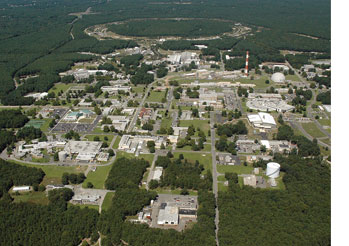Brookhaven National Laboratory Site
 In 1946, representatives from nine major eastern universities - Columbia, Cornell, Harvard, Johns Hopkins, Massachusetts Institute of Technology, Princeton, University of Pennsylvania, University of Rochester, and Yale - formed a nonprofit corporation to establish a new nuclear-science facility, and they chose a surplus army base “way out on Long Island” as the site. Thus, Brookhaven National Laboratory was born. On March 21, 1947, the U.S. War Department transferred the site of Camp Upton on Long Island to the U.S. Atomic Energy Commission (AEC), which was the federal agency that oversaw the founding of Brookhaven National Laboratory and was a predecessor to the present U.S. Department of Energy (DOE). The AEC provided the initial funding for Brookhaven’s research into the peaceful uses of the atom, with the goal of improving public well-being. In 1946, representatives from nine major eastern universities - Columbia, Cornell, Harvard, Johns Hopkins, Massachusetts Institute of Technology, Princeton, University of Pennsylvania, University of Rochester, and Yale - formed a nonprofit corporation to establish a new nuclear-science facility, and they chose a surplus army base “way out on Long Island” as the site. Thus, Brookhaven National Laboratory was born. On March 21, 1947, the U.S. War Department transferred the site of Camp Upton on Long Island to the U.S. Atomic Energy Commission (AEC), which was the federal agency that oversaw the founding of Brookhaven National Laboratory and was a predecessor to the present U.S. Department of Energy (DOE). The AEC provided the initial funding for Brookhaven’s research into the peaceful uses of the atom, with the goal of improving public well-being.
Brookhaven Lab was conceived to promote basic research in the physical, chemical, biological and engineering aspects of the atomic sciences. An equally important concept was the establishment of a national laboratory in the Northeast to design, construct and operate large scientific machines that individual institutions could not afford to develop on their own. The Laboratory was also to resemble a university to the greatest extent possible.
Today, Brookhaven Lab is one of ten national laboratories under DOE’s Office of Science, which provides the majority of the Laboratory’s research dollars and direction. Founded in 1977 as the 12th cabinet-level department, DOE oversees much of the science research in this country through its Office of Science. |
 |



 In 1946, representatives from nine major eastern universities - Columbia, Cornell, Harvard, Johns Hopkins, Massachusetts Institute of Technology, Princeton, University of Pennsylvania, University of Rochester, and Yale - formed a nonprofit corporation to establish a new nuclear-science facility, and they chose a surplus army base “way out on Long Island” as the site. Thus, Brookhaven National Laboratory was born. On March 21, 1947, the U.S. War Department transferred the site of Camp Upton on Long Island to the U.S. Atomic Energy Commission (AEC), which was the federal agency that oversaw the founding of Brookhaven National Laboratory and was a predecessor to the present U.S. Department of Energy (DOE). The AEC provided the initial funding for Brookhaven’s research into the peaceful uses of the atom, with the goal of improving public well-being.
In 1946, representatives from nine major eastern universities - Columbia, Cornell, Harvard, Johns Hopkins, Massachusetts Institute of Technology, Princeton, University of Pennsylvania, University of Rochester, and Yale - formed a nonprofit corporation to establish a new nuclear-science facility, and they chose a surplus army base “way out on Long Island” as the site. Thus, Brookhaven National Laboratory was born. On March 21, 1947, the U.S. War Department transferred the site of Camp Upton on Long Island to the U.S. Atomic Energy Commission (AEC), which was the federal agency that oversaw the founding of Brookhaven National Laboratory and was a predecessor to the present U.S. Department of Energy (DOE). The AEC provided the initial funding for Brookhaven’s research into the peaceful uses of the atom, with the goal of improving public well-being.